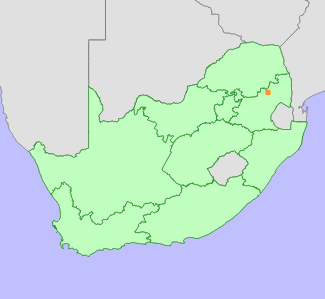|
Scientific Name | Disa vigilans McMurtry, T.J.Edwards & Bytebier |
Higher Classification | Monocotyledons |
Family | ORCHIDACEAE |
National Status |
Status and Criteria | Endangered D |
Assessment Date | 2012/08/30 |
Assessor(s) | D. McMurtry, S. Burns, L. Grobler & L. von Staden |
Justification | A recently described species, known from a single subpopulation on the Drakensberg Escarpment near Lydenburg. Its habitat is extensively transformed by pine plantations, and the population occurs in a small, remnant grassland fragment in a firebreak between plantations. It has probably declined in the past, but since its discovery in 2000, it has not declined. The population consists of fewer than 250 mature individuals. |
Distribution |
Endemism | South African endemic |
Provincial distribution | Mpumalanga |
Range | Mpumalanga Escarpment near Lydenburg. |
Habitat and Ecology |
Major system | Terrestrial |
Major habitats | Long Tom Pass Montane Grassland |
Description | North-eastern mountain sourveld between Black Reef Quartzite boulders, at the escarpment edge in exposed, windswept sites, 2100-2150 m. |
Threats |
| The habitat of this species is extensively transformed by pine plantations, and the two known subpopulations occur in small remaining grassland fragments in firebreaks between plantations. This species has probably declined in the past, but since it was only discovered in 2000, the extent of the decline is unknown.
The firebreaks are maintained according to government regulations, and the sites are unlikely to be converted to plantations in the near future. Frequent burning will prevent pine seedlings from invading the grasslands, and at present there is no evidence that this species is negatively affected by too frequent burning. |
Population |
This species shares a similar distribution with, and is closely related to Disa amoena. D. amoena however occurs in large subpopulations and is much more common than D. vigilans (McMurtry et al. 2006). This species is known only from a small area of grassland, a firebreak between exotic timber plantations about 1 km long, where there are around 150 plants in two clumps.
|
Population trend | Stable |
Assessment History |
Taxon assessed |
Status and Criteria |
Citation/Red List version | | Disa vigilans McMurtry, T.J.Edwards & B.Bytebier | EN D | Raimondo et al. (2009) | |
Bibliography |
McMurtry, D., Edwards, T.J. and Bytebier, B. 2006. A new species of Disa (Orchidaceae) from Mpumalanga, South Africa. South African Journal of Botany 72:551-554.
McMurtry, D., Grobler, L., Grobler, J. and Burns, S. 2008. Field guide to the Orchids of northern South Africa and Swaziland. Umdaus Press, Hatfield.
Raimondo, D., von Staden, L., Foden, W., Victor, J.E., Helme, N.A., Turner, R.C., Kamundi, D.A. and Manyama, P.A. 2009. Red List of South African Plants. Strelitzia 25. South African National Biodiversity Institute, Pretoria.
|
Citation |
| McMurtry, D., Burns, S., Grobler, L. & von Staden, L. 2012. Disa vigilans McMurtry, T.J.Edwards & Bytebier. National Assessment: Red List of South African Plants version 2024.1. Accessed on 2025/10/30 |
 Comment on this assessment
Comment on this assessment


